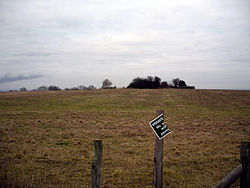Woolbury
| Woolbury | |
|
Hampshire | |
|---|---|
 Woolbury Ring | |
| Type: | Hill fort |
| Location | |
| Grid reference: | SU381353 |
| Location: | 51°6’57"N, 1°27’26"W |
| History | |
| Built Iron Age | |
| Information | |
Woolbury, or Woolbury Ring, is the site of an Iron Age univallate hill fort on Stockbridge Down, Hampshire. It is to the east of the village of Stockbridge, on a hill with a summit of 518 feet above sea level.
Close by is another hill fort, Danebury, which is found to the west, across the River Test.
Description
The site is described as a strong hilltop camp covering 20 acres, with a single bank and ditch, and has commanding views over the surrounding area. The bank and ditch are well preserved to the west, the bank being 9 feet. high and 16 feet. above the bottom of the ditch. The eastern side has been ploughed out, and the ditch only remains to the north and south. The entrance is on the west side, the interior is down to permanent pasture. Only the south-west rampart (which includes the original entrance) is in National Trust ownership; the rest is private land.[1]
The site is listed as a scheduled ancient monument.[2]
A number of other archaeological sites are scattered across the area, including a Bronze Age bowl barrow mound at SU395363, approximately 45 yards in diameter and 5 feet in height. It is recorded in an Anglo-Saxon charter as Heardulfes Hlæwe or Heardulf's Barrow.[3][4] The area is now subject to ploughing. In addition, several other tumuli are to be found to the south of the hill fort.
White horse and cross
On the southern ramparts of Woolbury Ring is a hill figure of a horse. Whilst there are several white horse hill figures across the land, nine nearby in Wiltshire alone, this is the only example in Hampshire. The horse was constructed crudely of rough flints, painted white and pushed into the ground to form the shape of the horse. The earliest documentation of the horse is in 1846. The horse for many years was covered by the surrounding bushes but in 1999, the site was cleared so the horse become visible again.[5]
There was also a hill figure of a cross nearby only a few yards from Winchester Road, constructed using the same method.[6] This was lost in 1944.[7]
References
- ↑ Megalithic Portal: Woolbury
- ↑ National Heritage List 1003531: Woolbury Ring (Historic England)
- ↑ Arch. J. Vol. 83, 1926, (Grundy), p.173.
- ↑ P.H.F.C., Vol. 14, 1938-40, (Grinsell), pp.31, 351
- ↑ Hows, Mark. "Woolbury Horse". http://www.hows.org.uk/personal/hillfigs/wool/wool.htm.
- ↑ "Wiltshire White Horses: Other non-Wiltshire white horses". http://www.wiltshirewhitehorses.org.uk/others.html.
- ↑ Hows, Mark. "Woolbury Cross". http://www.hows.org.uk/personal/hillfigs/lost/wool.htm.